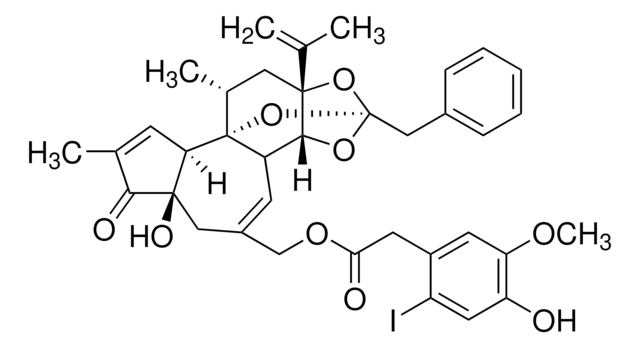L9504
D-Luciferin
luminescent, ≥98% (HPLC), powder
Synonym(s):
(S)-2-(6-Hydroxy-2-benzothiazolyl)-2-thiazoline-4-carboxylic acid, 4,5-Dihydro-2-(6-hydroxy-2-benzothiazolyl)-4-thiazolecarboxylic acid, Firefly Luciferin
About This Item
Recommended Products
product name
D-Luciferin, synthetic
biological source
synthetic
assay
≥98% (HPLC)
form
powder
solubility
DMSO: 10 mg/mL, clear, colorless to faintly yellow
fluorescence
λex 328 nm; λem 532 nm in H2O
storage temp.
−20°C
SMILES string
OC(=O)[C@H]1CSC(=N1)c2nc3ccc(O)cc3s2
InChI
1S/C11H8N2O3S2/c14-5-1-2-6-8(3-5)18-10(12-6)9-13-7(4-17-9)11(15)16/h1-3,7,14H,4H2,(H,15,16)/t7-/m1/s1
InChI key
BJGNCJDXODQBOB-SSDOTTSWSA-N
Looking for similar products? Visit Product Comparison Guide
General description
Application
Biochem/physiol Actions
Application
replaced by
Storage Class
11 - Combustible Solids
wgk_germany
WGK 3
flash_point_f
Not applicable
flash_point_c
Not applicable
ppe
Eyeshields, Gloves, type N95 (US)
Certificates of Analysis (COA)
Search for Certificates of Analysis (COA) by entering the products Lot/Batch Number. Lot and Batch Numbers can be found on a product’s label following the words ‘Lot’ or ‘Batch’.
Already Own This Product?
Find documentation for the products that you have recently purchased in the Document Library.
Customers Also Viewed
Articles
seMpai substrate is suitable for near-infrared BLI in biological experiments, offering high solubility for extended bioluminescent applications.
Bioluminescence imaging (BLI) systems allows for high-sensitive and noninvasive monitoring of cell proliferation, activity of signaling pathways and protein-protein interactions in living tissues.
Firefly luciferase is a sensitive reporter for gene studies due to its absence in mammalian cells or tissues.
Chromatograms
application for HPLCapplication for HPLCOur team of scientists has experience in all areas of research including Life Science, Material Science, Chemical Synthesis, Chromatography, Analytical and many others.
Contact Technical Service








